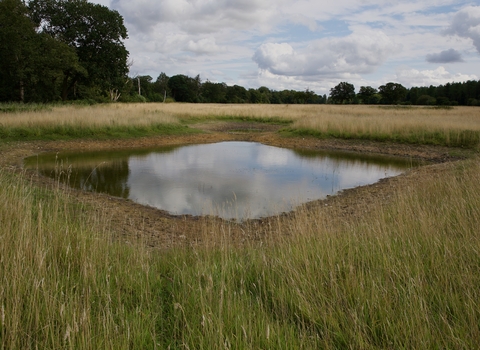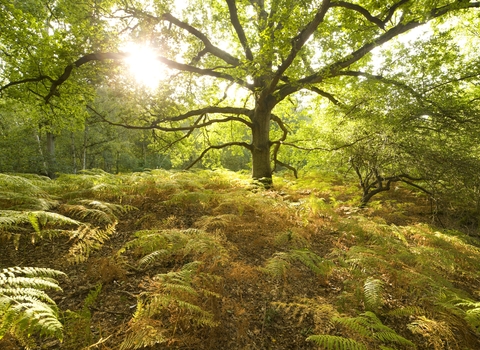
Ghost pingo excavation (credit: Jimmy King)
The Lost Ponds: Reinstating Ghost Pingos
The Lost Ponds: Reinstating Ghost Pingos project aimed to map, understand and recreate the ghost pingos lost from the Brecks Fen Edge and Rivers landscape area, enabling species expansion and movement across the countryside. A key output was the creation of a 'Restoring Ghost Pingos' guide, to allow others to carry out similar work.
Read ghost pingo report in full
The project helped to disseminate best practise and scientific analysis to landowners and others in the region to facilitate future pingo reinstatement.
Using advanced mapping technology, and on-the-ground analysis, the project team discovered and re-excavated 15 buried ‘ghost’ pingo ponds hidden beneath the landscape. Eleven of these ghost pingos were at NWT’s Watering Farm, adjacent to NWT Thompson Common reserve, and four were on two nearby sites owned by separate landowners. Most ponds are man-made features, but in the Breckland and Fen edge there are some truly ancient ponds and depressions, often known collectively as ‘pingos’, which originated through natural glacial processes at the end of the last Ice Age, over 10,000 years ago. ‘Ghost’ pingos are pingos that have been filled in by humans, normally to facilitate larger scale agricultural production.
The project was part of the Brecks Fen Edge and Rivers Landscape Partnership, with funding from National Lottery Heritage Fund, working in partnership with University College London, the Norfolk Geodiversity Partnership and Norfolk Ponds Project.
Project outcomes
We excavated a total of 15 ghost pingos over three years: 11 on NWT-managed Watering Farm and four more working with two landowners close to Watering Farm. Together with other experts including University College London, the Norfolk Geodiversity Partnership and Norfolk Ponds Project, we produced new guidance on the restoration of these ancient ponds.
Volunteers played an important role in the project by monitoring water levels in ghost pingo areas pre and post restoration. The pre-restoration water level data was crucial in calculating whether ghost pingos would hold water should they be restored, which was a major factor in whether the restoration went ahead. Post restoration monitoring helped validate initial expectations and fine tune the appraisal process.
A ‘live pingo’ excavation event in August provided an opportunity for attendees to be trained in best practice for restoring ghost pingos. The NWT Machinery Operator, who was involved from the beginning of the project, partially excavated an identified feature on Watering Farm before the day to show event attendees what the initial stages of the excavation should look like and the reasoning behind this method.
Summary of pingo surveys
Survey and monitoring work throughout the project found an astonishing biodiversity boost in the restored pingos. Over 90 wetland plant species, including rare and internationally significant species such as fen pondweed, various-leaved pondweed, and lesser bearded stonewort. Nine of the excavated ghost pingos met the criteria to be classified as priority habitats due to the rarity of the plants regenerating from the previously buried seedbank which the careful project excavation exposed.
The revitalised pingos also attracted an impressive array of wildlife. Surveys documented 50 water beetle species, 15 of which are of conservation concern. Amphibians and reptiles—including common frogs, toads, and great crested newts—were also recorded.
How we’ll build on this project?
This project was the first of its kind and the main objective was to see if reinstatement of a ghost pingo can be done and how best to approach the process. The project has shown that extremely positive results can be achieved in just one or two years post restoration.
Going forwards, fuller monitoring data will be available, including details of rarer species that have emerged in the restored pingos. This data combined with the Restoring Ghost Pingo guidance document, will be hugely valuable to any other landowners seeking to reinstate these natural features following best practice.
The processes used in this project have already been replicated by NWT in a habitat restoration project at a site near Thompson Common and Watering Farm. Ghost pingos at NWT-owned Mere Farm have been excavated using the experience gained and knowledge learned during the Lost Ponds project to reinstate and expand suitable habitat for pool frogs, which will also benefit other associated wildlife







